Indianapolis Motor Speedway
Introduction
Text-to-speech Audio
Images
A look down the front Stretch
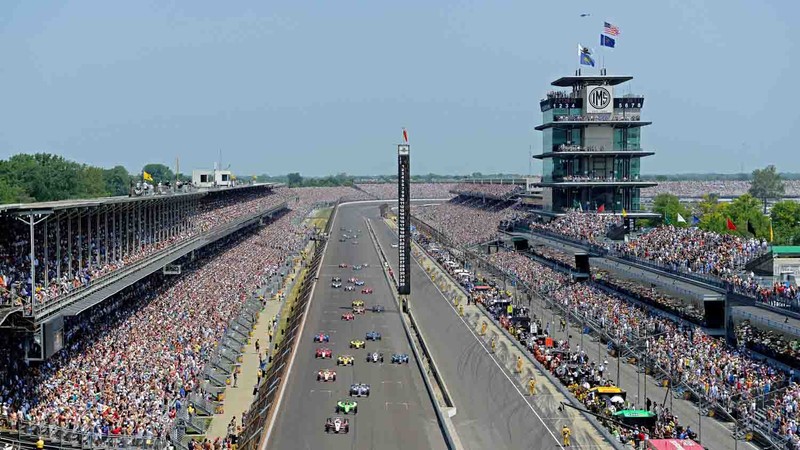
Overhead View
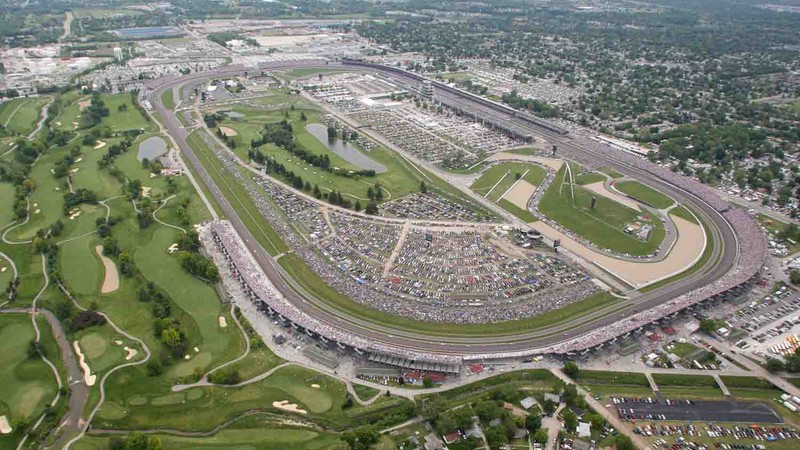
A look at the Iconic Bricks
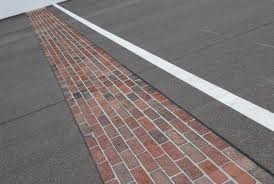
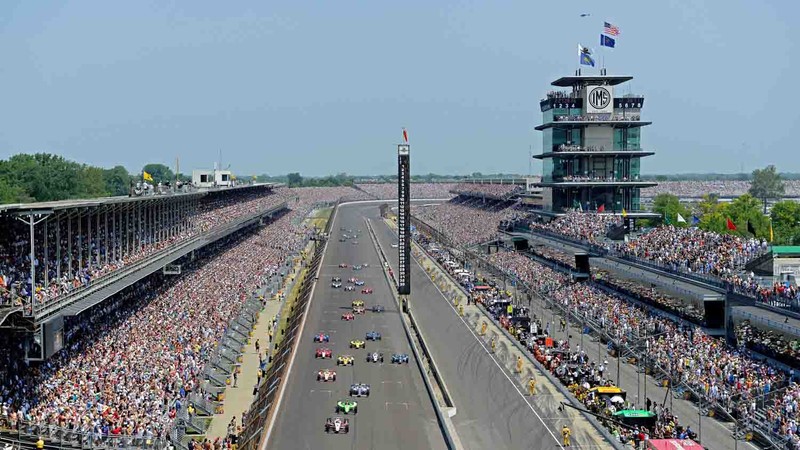
Carl Graham Fisher (1874–1938) of Indiana, an American vehicle parts and highway entrepreneur, co-founder and first president of the Indianapolis Motor Speedway. Photo taken May of 1909. The Library of Congress, George Grantham Bain Collection
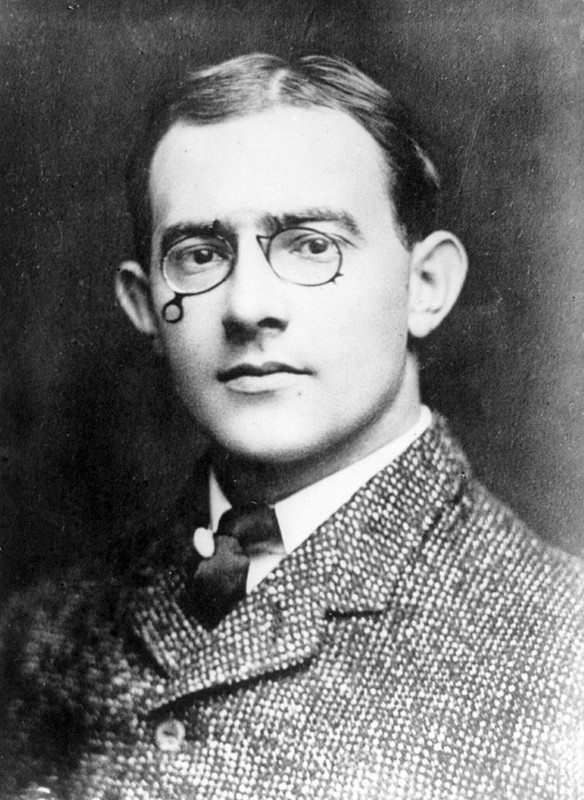
The Indianapolis Motor Speedway under construction. Courtesy of the Library of Congress
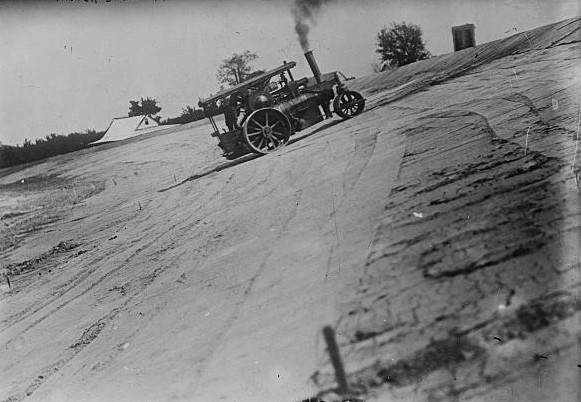
1909 artist's rendition of the original speedway plan (not an actual picture).
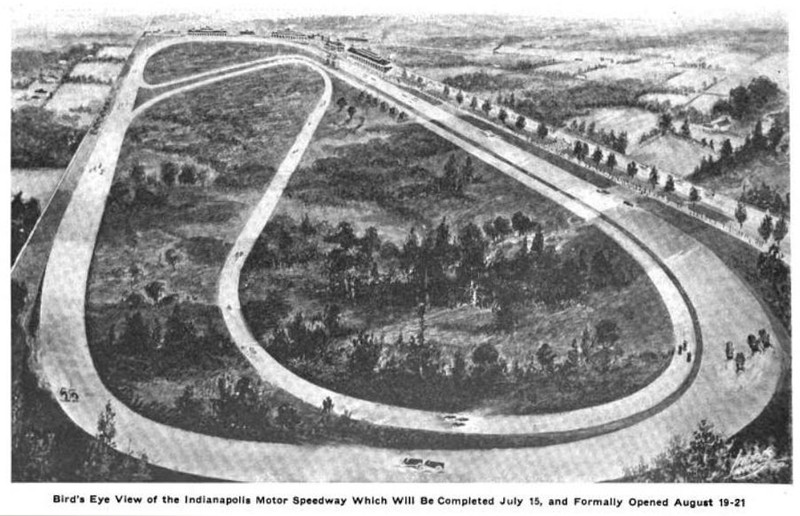
1909 poster advertising the speedway. Courtesy of the Library of Congress

Indianapolis Motor Speedway logo
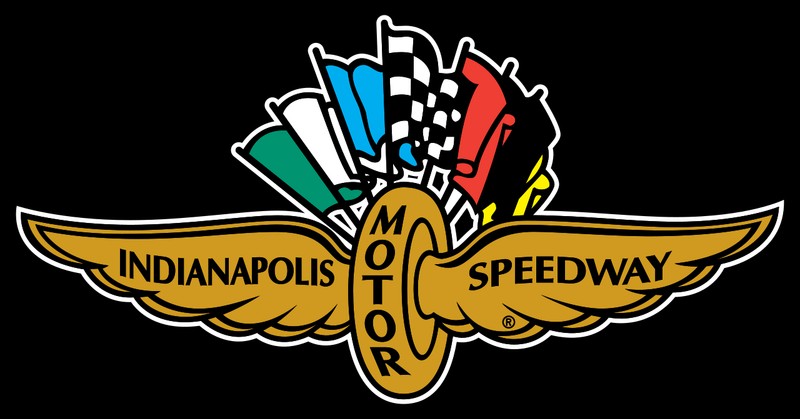
Backstory and Context
Text-to-speech Audio
NASCAR may be the premier racing attraction in the country but when it comes to the Brickyard the most famous race that takes place at this track is the Indianapolis 500. The Verizon IndyCar Series has their biggest event at the track that draws the attraction of everybody. The Brickyard is one of the most renowned tracks that there is. NASCAR has the Brickyard 400 every year here and just like the winner of the Indianapolis 500. The winner kisses the bricks as a symbolic gesture.
The track is one of the oldest track in the circuit with it being constructed in 1909. The track is owned by the Indianapolis Motor Speedway Corporation a subsidiary of Hulman and Co. The tracks racing surface is a combination of asphalt paving and bricks. The speedway has the highest sporting venue capacity in the world having a capacity of 257,325 with it possibly going as high as 400,000. The tracks construction cost was at 3 million dollars.
Besides just the oval track that both NASCAR and the IndyCar Series races on the track also sports an infield road course. The Brickyard is the only automotive racing place that is placed on the National Register of Historic Places. The track is a very versatile track that can go from only having 4 turns to having an amazing total of 13 turns for the road course races. On top of the track being a must seen site. The ground of the speedway also sports another attraction, The Indianapolis Motor Speedway Museum.
Additional Information (Early History to 1940s):
Indianapolis businessman Carl G. Fisher first envisioned building the speedway in 1905 after assisting friends racing in France and seeing that Europe held the upper hand in automobile design and craftsmanship. Fisher began thinking of a better means of testing cars before delivering them to consumers. At the time, racing was just getting started on horse tracks and public roads. Fisher noticed how dangerous and ill-suited the makeshift courses were for racing and testing. He also argued that spectators did not get their money's worth, as they were only able to get a brief glimpse of cars speeding down a linear road.
Fisher proposed building a circular track 3 to 5 miles long with smooth 100–150-foot-wide surfaces. Such a track would give manufacturers a chance to test cars at sustained speeds and give drivers a chance to learn their limits. Fisher predicted speeds could reach up to 120 mph on a 5-mile course. He visited the Brooklands circuit outside London in 1907, and after viewing the banked layout, it solidified his determination to build the speedway. With dozens of car makers and suppliers in Indiana, Fisher proclaimed, "Indianapolis is going to be the world's greatest center of horseless carriage manufacturer, what could be more logical than building the world's greatest racetrack right here?"
Fisher began looking around the Indianapolis area for a site to build his track; he rejected two potential sites before finding level farmland, Pressley Farm, totaling 328 acres about 5 miles outside of Indianapolis. In December 1908, he convinced James A. Allison, Arthur Newby, and Frank W. Wheeler to join him in purchasing the property for $72,000. The group incorporated the Indianapolis Motor Speedway Company on March 20, 1909, with a capitalization of $250,000, with Fisher and James Allison in for $75,000 apiece and Frank Wheeler and Arthur Newby on board for $50,000 each.
Construction of the track started in March 1909. Fisher had to quickly downsize his planned 3-mile oval with a 2-mile road course to a 2.5-mile oval to leave room for the grandstands. Reshaping of the land for the speedway took 500 laborers, 300 mules and a fleet of steam-powered machinery. The track surface consisted of graded and packed soil covered by 2 inches of gravel, 2 inches of limestone covered with taroid (a solution of tar and oil), 1–2 inches of crushed stone chips that were also drenched with taroid, and a final topping of crushed stone. Workers also constructed dozens of buildings, several bridges, grandstands with 12,000 seats, and an 8-foot perimeter fence. A white-with-green-trim paint scheme was used throughout the property.
The first event ever held at the speedway was a helium gas-filled balloon competition on Saturday, June 5, 1909, more than two months before the oval was completed The event drew a reported 40,000 people. Nine balloons lifted off "racing" for trophies; a balloon by the name of Universal City won the race, landing 382 miles away in Alabama after spending more than a day aloft. The first motorsport event at the track consisted of seven motorcycle races, sanctioned by the Federation of American Motorcyclists (FAM), on August 14, 1909. This was originally planned as a two-day, 15-race program, but ended before the first day was completed due to concerns over suitability of the track surface for motorcycle use. These early events were largely planned by one of the top names in early auto racing promotion, Ernest Moross, who earned fame for his bold and sometimes outlandish barnstorming events at fairgrounds tracks with racing star Barney Oldfield.
On August 19, 1909, fifteen carmakers' teams arrived at the track for practice. The track surface again became a concern with drivers being covered in dirt, oil, and tar and with ruts and chuckholes beginning to form in the turns. Speedway workers oiled and rolled the track prior to the gates opening to the public. Fifteen to twenty thousand spectators showed up, paying at the most $1 for a ticket. Halfway through the first 250-mile event, race leader Louis Chevrolet was temporarily blinded when a stone smashed his goggles. Wilfred Bourque, driving in a Knox, suffered a suspected rear-axle failure resulting in his car flipping end over end on the front stretch before crashing into a fence post. Both he and his mechanic, Harry Halcomb, died at the scene.
The first day of car racing resulted in four finishes and two land speed records, but concerns over safety led AAA officials to consider canceling the remaining events. Fisher promised the track would be repaired by the next day and convinced officials that the show should go on. The second day saw 20,000 spectators, no major incidents, and additional speed records broken.
On the third day of racing, 35,000 spectators showed up to watch the grand finale 300-mile race. At 175 miles into the race, the right front tire blew on Charlie Merz's car. His car mowed down five fence posts and toppled dozens of spectators. Two spectators and his mechanic, Claude Kellum, were killed in the crash. Ten laps later, driver Bruce Keen struck a pothole and crashed into a bridge support. The race was then halted and the remaining drivers given engraved certificates instead of trophies. The race resulted in the AAA boycotting any future events at the speedway until significant improvements were made.
Fisher and his partners began looking into the idea of paving the track with bricks or concrete. Paving in 1909 was still relatively new with only a few miles of public roads paved, leaving little knowledge of what would work best. Traction tests were conducted on bricks, proving they could hold up. Less than a month after the first car races, the repaving project began. Five Indiana manufacturers supplied 3.2 million 10-pound bricks to the track. Each was hand laid over a 2-inch cushion of sand, then leveled and the gaps filled with mortar. At the same time, a concrete wall 33 inches tall was constructed in front of the main grandstand and around all four corners to protect spectators. The final brick added to the track was made of gold and laid in a special ceremony by Governor Thomas R. Marshall. Before the work was completed, locals nicknamed the track the "Brickyard". Today, 3 feet, or one yard, of original bricks remain at the start-finish line.
In December 1909, eleven drivers and a few motorcyclists returned for speed trials. Drivers soon reached speeds of up to 112 mph on the new surface. Racing returned in 1910, with a total of 66 automobile races held during three holiday weekends (Memorial Day, Fourth of July and Labor Day). Each weekend featured two or three races of 100 to 200 miles, with several shorter contests. Each race stood on its own and earned its own trophy. All races were sanctioned by the AAA (as were the Indianapolis 500 races through 1955). 1910 also saw the speedway host the National Aviation Meet, featuring Wilbur and Orville Wright and highlighted by Walter Brookins setting a world record by taking a plane up to 4,938 feet.
A change in marketing focus led to only one race per year beginning in 1911. An estimated 80,000 spectators attended the first 500-mile race on Memorial Day, May 30, 1911. Forty cars competed with Ray Harroun winning at an average speed of 74.602 miles per hour. While all the other drivers in the race had a riding mechanic in their car, Harroun decided to save weight and go faster by driving solo. So, to be able to see what was happening behind his No. 32 Marmon "Wasp", he installed a rear-view mirror. It was the first time such a device was used in an automobile.
A classic race followed in 1912, when Ralph DePalma lost a five lap lead with five laps to go after his car broke down. As DePalma pushed his car around the circuit, Joe Dawson made up the deficit to win. Three of the next four winners were European, with DePalma being the exception as an American national, though originally Italian born. These races gave Indy a worldwide reputation and international drivers began to enter. The 1916 race was shortened to 120 laps, for a number of reasons including a lack of entries from Europe (there were so few entries that the speedway itself entered several cars), a lack of oil, and out of respect for the war in Europe.
On September 9, 1916, the speedway hosted a day of short racing events termed the "Harvest Classic", composed of three races held at 20-, 50-, and 100-mile distances. In the end, Johnny Aitken, in a Peugeot, would win all three events, his final victories at the facility. The Harvest Classic contests were the last races other than the Indianapolis 500 to be held on the grounds for seventy-eight years.
Racing was interrupted in 1917–1918 by World War I, when the facility served as a military aviation repair and refueling depot. When racing resumed, speeds quickly increased. In 1921, speedway co-founder Wheeler committed suicide. At the 1925 event, Pete DePaolo became the first to average 100 mph for the race, with a speed of 101.13 mph. In 1926, Fisher and Allison were offered "a fortune" for the speedway site by a local real estate developer. They refused, selling instead to former racing driver (and World War One fighter ace) Edward V. Rickenbacker in 1927. How much he paid was not revealed. Rickenbacker built a golf course in the infield The next year, Allison died from pneumonia.
With the Great Depression hitting the nation, the purse dropped from a winners share of $50,000 and a total of $98,250 in 1930 to $18,000 and $54,450 respectively. There is a common misconception the rules were "dumbed down" to what was called the "junkyard formula" to allow more entries during the depression. The rules were indeed changed, but it was due to an effort by the speedway to get more car manufacturers involved in the race by discouraging the entry of specialized racing machines which dominated the 500 during the mid- to late-'20s. The rule changes, in fact, were already being laid out before the market crash. In 1931, Dave Evans performed a remarkable feat when his Cummins Diesel Special completed the entire 500 miles without a pit stop. It was also the first diesel entrant.
In 1933, a record 42 cars started the 500. For 1934, a maximum fuel consumption limit was imposed, 45 US gal. It became 42.5 US gal in 1935 and 37.5 US gal in 1936. When the limits resulted in several top competitors running out of fuel in the closing stages, the limits were abandoned, though the use of pump gasoline was still mandatory.
By the early 1930s, rising race speeds began to make the track increasingly dangerous, and in the period 1931–1935 there were 15 fatalities. This forced another re-pavement, with tarmac replacing the bricks in parts of the track. In addition, during the 1935–36 seasons the inside wall was removed in the corners, the outside wall was realigned (to change the angle compared to the track, reducing the potential for cars to vault over it), hard crash helmets became mandatory, and the first yellow light system was installed around the track. The continuing track dangers during this period, however, did not stop Louis Meyer or Wilbur Shaw from becoming the first two three-time winners, with Shaw also being the first back-to-back winner in 1939 and 1940.
At the beginning of the 1940s, the track required further improvements. In 1941, about a third of "Gasoline Alley" (the garage area) burned down before the race. With U.S. involvement in World War II, the 1942 500-mile race was cancelled in December 1941. Late in 1942, a ban on all auto racing led to the canceling of the 500-mile race for the rest of the war, for a total of three years (1942–1945). The track was more or less abandoned during the war and fell into a state of disrepair.
Many of the locals conceded that the speedway would be sold after the war and become a housing development. With the end of the war in sight, on November 29, 1944, three-time 500 winner Wilbur Shaw came back to do a 500-mile tire test approved by the government for Firestone. Shaw was shocked at the dilapidated state of the speedway and contacted owner Eddie Rickenbacker, only to discover that it was for sale. Shaw then sent out letters to the automobile industry to try to find a buyer. All the responses indicated that the speedway would be turned into a private facility for the buyer. Shaw then looked around for someone to buy the speedway, who would reopen the racetrack as a public venue. He found Terre Haute businessman Tony Hulman. Meetings were set up and the speedway was purchased on November 14, 1945. Though not officially acknowledged, the purchase price for the speedway was reported by the Indianapolis Star and News to be $750,000. Major renovations and repairs were made at a quick pace to the frail speedway, in time for the 1946 race. Since the record 42 cars that started the 1933 edition of the 500, the field size has been set at 33 drivers, with only three exceptions to this rule, the first being 1947, when only 30 cars started due to a strike by certain teams affiliated with the ASPAR drivers, owners and sponsors association. Int the decades that followed, additional stands and facilities have turned the racetrack into the largest sporting venue in the world. The stands now include suites, and a museum was added to accommodate year-round visitors to this historic track.
Sources
"Indianapolis Motor Speedway – World of Stadiums". Worldofstadiums.com. August 12, 1909. Retrieved 02/22/2017
Kettlewell, Mike. "Indianapolis: The Richest Race in the World", in Northey, Tom, ed. World of Automobiles (London: Orbis, 1974), Volume 9, pp.1014-1015
